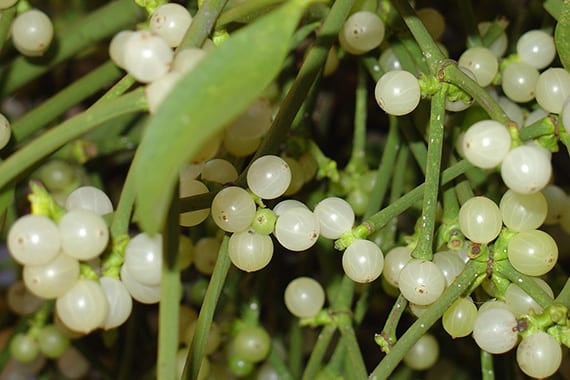
It is common to see on these dates on the doors or their lintels twigs of mistletoe. An ancient Christmas tradition says it will bring the happiness to the house where you are and love and fertility to couples who kiss under its branches. The truth is that tradition has meant that this species has been in danger of extinction in many of their natural places of origin. So, although the tradition is not as widespread in Spain as in the rest of Europe or throughout America, if you decide to hang the mistletoe sprig in your home, make sure it corresponds to nursery crops.
The mistletoe, along with the Poinsettia and holly, is one of the species most associated with the Christmas. It has been considered a magic plant, with medicinal properties, since ancient times. In fact, the ancient Celtic Druids already used it in their potions.
El mistletoe It is a plant full of symbolism, about which there are many stories and legends. The Roman historian Pliny recounted in his Natural History how mistletoe was already used by ancient Celtic priests and magicians, who considered it a magical plant. Its collection was developed following a complex ritual that included very specific collection dates, always close to the winter solstice, and the use of specific tools, generally a golden sickle. Once cut, the mistletoe was placed on a white garment, preventing it from touching the ground or falling to the ground.
One of the most peculiar characteristics of mistletoe is its ability to root on the living tissue of other plants and not on the ground. Its berries, first green and white, when ripe, contain a gelatinous substance, with which they stick to the trunks, and then germinate and take root.
It grows preferentially on the branches of holm oaks, pines, apple trees and oaks, in what at first glance looks like a skein of ball-shaped stems, and feeds on their sap, hence its parasitic nature.
Magical powers
Some legends attribute magical powers to this plant based on the fact that it was created as an element that did not come from either the sky or the earth, since its roots never touch the earth, but neither does it stand by itself in the air. From this arises the custom or tradition of collecting it without falling to the ground, and of hanging it from the ceiling.
The Celts used this plant for a wide variety of applications: to protect themselves from lightning, evil, disease, to heal wounds or to help women in conception. They also considered it a symbol of peace and a powerful protective amulet. With it garlands were made with which the doors of the houses were adorned and that served to protect their inhabitants from evil spirits and to avoid unwanted visits. Since then mistletoe was considered a defense against witches and demons, and the custom of placing twigs on the household entrances.
The Christmas tradition says that a woman who receives a kiss under the mistletoe On Christmas Eve you will find the love you are looking for or keep the one you already have. If it is a couple, it will be presented with the gift of fertility.
More information - Poinsettia: how to survive Christmas